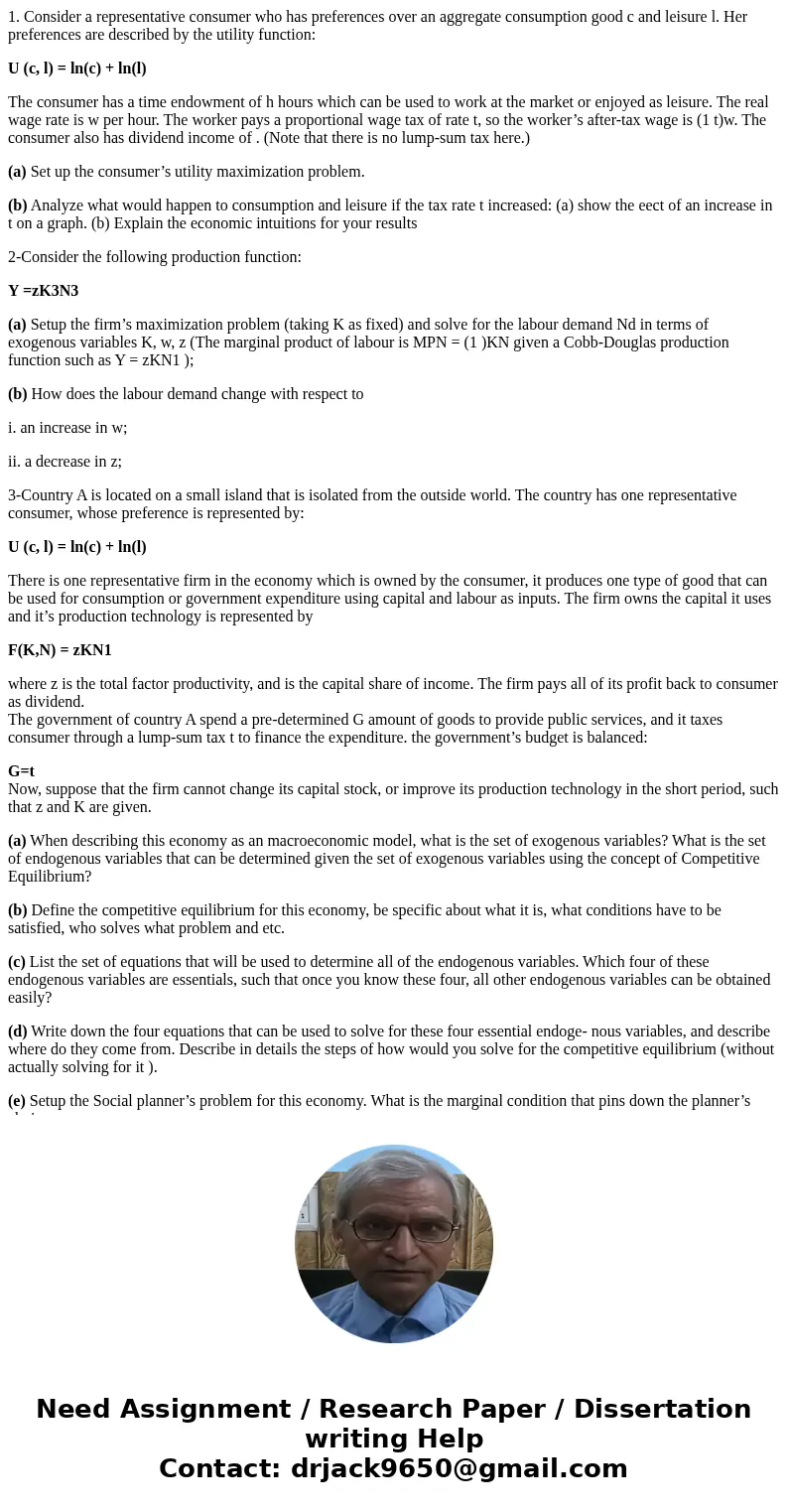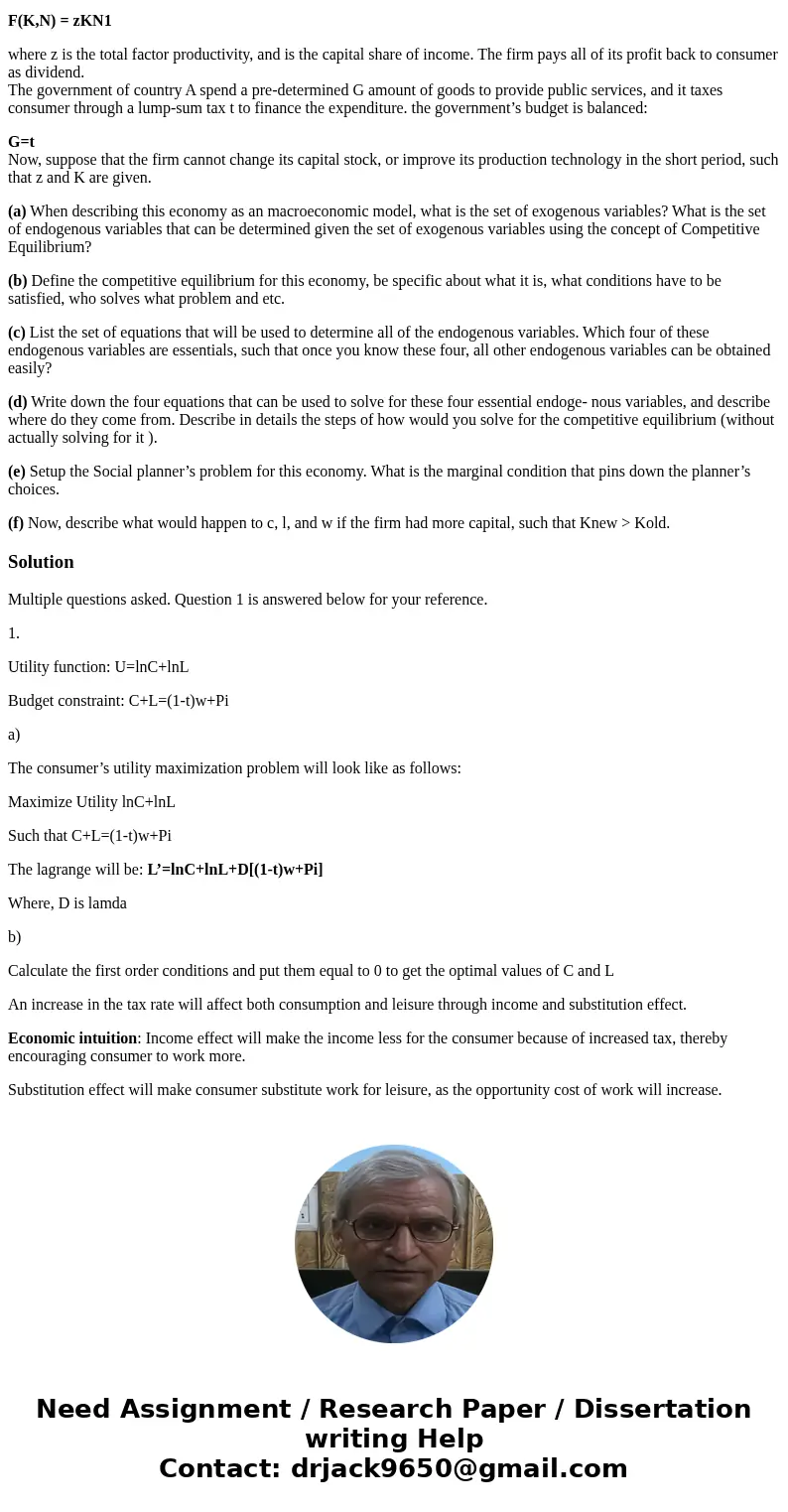1 Consider a representative consumer who has preferences ove
1. Consider a representative consumer who has preferences over an aggregate consumption good c and leisure l. Her preferences are described by the utility function:
U (c, l) = ln(c) + ln(l)
The consumer has a time endowment of h hours which can be used to work at the market or enjoyed as leisure. The real wage rate is w per hour. The worker pays a proportional wage tax of rate t, so the worker’s after-tax wage is (1 t)w. The consumer also has dividend income of . (Note that there is no lump-sum tax here.)
(a) Set up the consumer’s utility maximization problem.
(b) Analyze what would happen to consumption and leisure if the tax rate t increased: (a) show the eect of an increase in t on a graph. (b) Explain the economic intuitions for your results
2-Consider the following production function:
Y =zK3N3
(a) Setup the firm’s maximization problem (taking K as fixed) and solve for the labour demand Nd in terms of exogenous variables K, w, z (The marginal product of labour is MPN = (1 )KN given a Cobb-Douglas production function such as Y = zKN1 );
(b) How does the labour demand change with respect to
i. an increase in w;
ii. a decrease in z;
3-Country A is located on a small island that is isolated from the outside world. The country has one representative consumer, whose preference is represented by:
U (c, l) = ln(c) + ln(l)
There is one representative firm in the economy which is owned by the consumer, it produces one type of good that can be used for consumption or government expenditure using capital and labour as inputs. The firm owns the capital it uses and it’s production technology is represented by
F(K,N) = zKN1
where z is the total factor productivity, and is the capital share of income. The firm pays all of its profit back to consumer as dividend.
The government of country A spend a pre-determined G amount of goods to provide public services, and it taxes consumer through a lump-sum tax t to finance the expenditure. the government’s budget is balanced:
G=t
Now, suppose that the firm cannot change its capital stock, or improve its production technology in the short period, such that z and K are given.
(a) When describing this economy as an macroeconomic model, what is the set of exogenous variables? What is the set of endogenous variables that can be determined given the set of exogenous variables using the concept of Competitive Equilibrium?
(b) Define the competitive equilibrium for this economy, be specific about what it is, what conditions have to be satisfied, who solves what problem and etc.
(c) List the set of equations that will be used to determine all of the endogenous variables. Which four of these endogenous variables are essentials, such that once you know these four, all other endogenous variables can be obtained easily?
(d) Write down the four equations that can be used to solve for these four essential endoge- nous variables, and describe where do they come from. Describe in details the steps of how would you solve for the competitive equilibrium (without actually solving for it ).
(e) Setup the Social planner’s problem for this economy. What is the marginal condition that pins down the planner’s choices.
(f) Now, describe what would happen to c, l, and w if the firm had more capital, such that Knew > Kold.
Solution
Multiple questions asked. Question 1 is answered below for your reference.
1.
Utility function: U=lnC+lnL
Budget constraint: C+L=(1-t)w+Pi
a)
The consumer’s utility maximization problem will look like as follows:
Maximize Utility lnC+lnL
Such that C+L=(1-t)w+Pi
The lagrange will be: L’=lnC+lnL+D[(1-t)w+Pi]
Where, D is lamda
b)
Calculate the first order conditions and put them equal to 0 to get the optimal values of C and L
An increase in the tax rate will affect both consumption and leisure through income and substitution effect.
Economic intuition: Income effect will make the income less for the consumer because of increased tax, thereby encouraging consumer to work more.
Substitution effect will make consumer substitute work for leisure, as the opportunity cost of work will increase.


 Homework Sourse
Homework Sourse